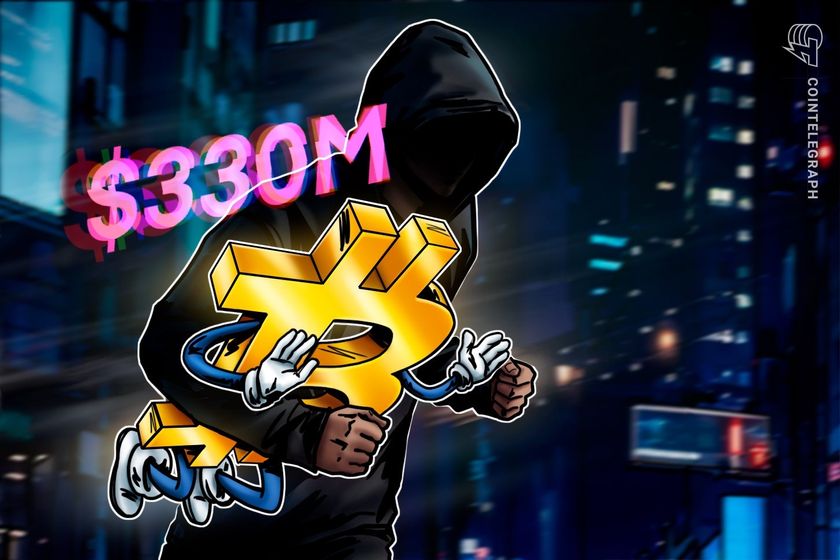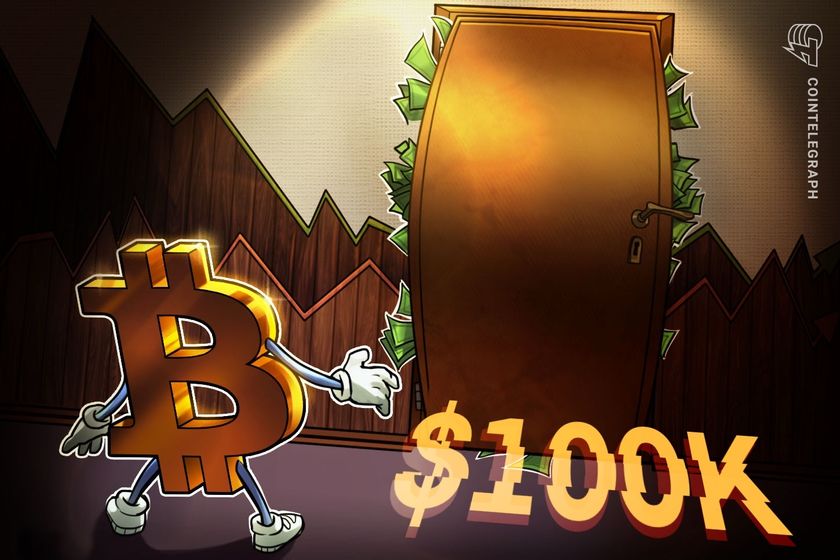News


Onchain sleuth ZachXBT has flagged a suspicious transfer involving 3,520 Bitcoin (BTC) (valued at $330.7 million) that may indicate a major theft. The transaction, reported on April 28, saw funds moved from a potential victim’s wallet to the address bc1qcry...vz55g.
Following the transfer, the stolen stash was quickly laundered through over six instant exchanges and swapped into privacy-focused cryptocurrency Monero (XMR).
The large-scale conversion led to a sharp 50% spike in XMR’s price, with the token reaching an intraday high of $339, according to data from CoinMarketCap.
At the time of writing, XMR has settled slightly but remains up 25% in the past 24 hours, trading at $289.
When asked whether North Korea’s Lazarus Group was behind the attack, ZachXBT dismissed the theory, stating it was “highly probable it’s not,” suggesting independent hackers were responsible.
Related: Kraken to end Monero support in European Economic Area
Vast majority of hackers use mainstream cryptos
In a recent comment to Cointelegraph, Chainalysis noted that most criminal transactions still rely on mainstream cryptocurrencies.
“While there are concerns of more criminals moving to privacy coins for anonymity, the vast majority of criminal activity still uses mainstream cryptocurrencies, such as Bitcoin, Ethereum and stablecoins,” Chainalysis said.
The firm added that these assets remain attractive because they offer the same benefits to bad actors as they do to legitimate users — cross-border functionality, instant settlement, and high liquidity.
Chainalysis noted that privacy coins pose limitations for criminals due to reduced liquidity and the fact that many major exchanges have delisted assets like Monero.
“Cryptocurrency is only useful if you can buy and sell goods and services or cash out into fiat, and that is much more difficult with privacy coins, especially as many mainstream exchanges have offboarded the use of privacy coins, such as Monero,” they explained.
The firm even said that blockchain transparency allows law enforcement to trace and recover illicit funds, regardless of the cryptocurrency used.
In 2024, a leaked Chainalysis video suggested that Monero transactions could be traceable despite the privacy-preserving nature of the blockchain.
The video reportedly showed how Chainalysis could track transactions back to 2021 via its own “malicious” Monero nodes.
Related: The IRS offers a $625,000 bounty to anyone who can break Monero and Lightning Network
Monero accepted at Spar stores in Switzerland
The suspected laundering operation comes as Monero is gaining wider retail acceptance. Two Spar supermarket locations in Switzerland recently began accepting XMR for payments.
The announcement, shared by Monero’s official X account, credits partnerships with DFX Swiss and OpenCryptoPay for enabling the integration.
One user, posting on April 25, shared their experience of purchasing organic cacao using XMR at a Spar store in Kreuzlingen.
In April 2025, Spar first tapped into the crypto market by introducing Bitcoin payments through the Lightning Network at outlets in Zug, Switzerland.
Magazine: Bitcoin $100K hopes on ice, SBF’s mysterious prison move: Hodler’s Digest, April 20 – 26


Key takeaways- Crypto-backed mortgages let you use assets like Bitcoin or Ether as collateral to secure a loan without selling your holdings.
- The process involves choosing a lender, securing your crypto in custody, appraising the property and finalizing loan terms.
- These mortgages offer tax advantages, streamlined approvals and the ability to retain crypto investment value while accessing liquidity.
- Platforms like Nexo provide tailored solutions, but thorough research is essential to ensure security and regulatory compliance.
Crypto-backed mortgages are a watershed moment in real estate financing because they let you use digital assets such as Bitcoin (BTC) or Ether (ETH) as collateral for a home loan.
Instead of selling your cryptocurrency, you pledge it to secure funds for buying property. This approach has been gaining traction as more people explore alternatives to traditional financing.
Furthermore, as the adoption of cryptocurrencies grows, crypto-backed mortgages are positioning themselves as a bridge between decentralized finance (DeFi) and traditional property markets, offering a unique solution for crypto holders looking to diversify their investments without forfeiting their digital wealth.
What are crypto-backed mortgages?
Crypto-backed mortgages are home loans where digital assets are used as collateral instead of cash or traditional assets.
Surprisingly, the process is straightforward: You transfer your cryptocurrency to a lender, who locks it up as collateral. In return, they provide a loan, often in fiat currency, to finance your property purchase. As long as you make timely payments, your crypto stays intact.
If the value of your collateral drops due to market volatility, you might need to add more assets to maintain the loan’s security — this is called a margin call.
What role does blockchain play in crypto-backed mortgages?
Blockchain technology makes this system transparent and efficient. Smart contracts, for example, automate much of the loan process, reducing paperwork and speeding up approvals. The blockchain’s immutable nature ensures every transaction is secure and verifiable, building trust between lenders and borrowers.
Crypto-backed mortgages are still emerging, but various platforms have already entered the market, offering tailored solutions for crypto investors.
As the adoption of blockchain in real estate grows, this innovative financing model is becoming more and more attractive.

Did you know? In 2012, BTCJam launched as one of the earliest platforms facilitating Bitcoin-backed loans, enabling individuals worldwide to borrow funds using Bitcoin as collateral. By 2016, BTCJam had serviced over 16,000 loans across more than 120 countries, with the average loan size ranging from $400 to $600.
The crypto-backed mortgage process
Navigating a crypto-backed mortgage involves several key steps:
- Eligibility criteria: Lenders typically accept major cryptocurrencies like Bitcoin and Ether as collateral. The required collateral value often exceeds the loan amount to account for market volatility. For instance, a lender might require collateral worth 150% of the loan value.
- Financial stability and regulatory compliance: Beyond crypto holdings, lenders assess your overall financial health, including income stability and credit history. Compliance with Anti-Money Laundering (AML) regulations is crucial; you’ll need to provide thorough documentation tracing the origin of your crypto assets to ensure they are legitimate.
- Application steps: Start by identifying lenders or platforms that accept cryptocurrency as collateral. Options may include specialized crypto lending platforms and certain traditional financial institutions. Once approved, you’ll transfer your crypto assets to a secure escrow or custodial account designated by the lender. This step ensures the lender can access the collateral if necessary.
- Property appraisal and loan finalization: The lender will conduct a property appraisal to confirm its market value. Afterward, you’ll finalize the loan terms, including interest rates and repayment schedules.
- Repayment and collateral management: Repayment structures vary; some loans may offer interest-only payments with a lump-sum principal repayment at the end, while others follow traditional amortization schedules. Interest rates can differ based on the lender and the loan’s specifics.
Given the volatile nature of cryptocurrencies, lenders monitor the value of your collateral. If its value drops below a certain threshold, you may face a margin call, requiring you to add more collateral or risk liquidation of your assets.
Did you know? When a homeowner fails to make mortgage payments, the lender may initiate a foreclosure to recover the outstanding loan balance. This legal process allows the lender to take ownership of the property and sell it to recoup losses.
Advantages of crypto-backed mortgages
- Preserving your crypto investments: Using your cryptocurrency holdings as collateral for a mortgage allows you to access funds without selling your assets. This means you can continue to benefit from any potential appreciation in value while securing the financing you need.
- Potential tax benefits: By leveraging your crypto assets as collateral instead of selling them, you may avoid triggering capital gains taxes. This strategy can be more tax-efficient, especially in jurisdictions where selling digital assets incurs significant tax liabilities.
- Streamlined approval process: Crypto-backed mortgages often place less emphasis on traditional credit scores. Lenders focus more on the value of your crypto collateral, which can simplify and expedite the approval process, making it more accessible for individuals with varying credit histories.
Did you know? Mississippi has one of the lowest mortgage approval rates in the US, with only 52.14% of applications approved between 2018 and 2022. This low approval rate is influenced by factors such as higher poverty levels, lower median incomes and elevated debt-to-income ratios among applicants. Additionally, racial disparities persist, with Black applicants facing higher denial rates compared to white applicants.
Risks and considerations
Despite the advantages, there are some risks you should be aware of:
- Cryptocurrency volatility: The value of cryptocurrencies can fluctuate significantly. If the value of your collateral drops below a certain threshold, lenders may issue a margin call, requiring you to provide additional assets to maintain the loan. Failure to do so could result in the liquidation of your crypto holdings.
- Regulatory and legal landscape: The regulatory environment for crypto-backed mortgages varies by jurisdiction and is continually evolving. It’s essential to understand the legal implications and ensure compliance with local laws, including AML regulations.
- Understanding loan terms: Thoroughly review the loan agreement to comprehend all terms, including interest rates, repayment schedules and conditions for margin calls. Being well-informed helps prevent unexpected challenges during the loan term.
Where can you leverage your crypto assets for real estate financing?
Several platforms already offer crypto-backed mortgages, allowing you to leverage your digital assets to purchase real estate. Here are some options:
- Nexo: Nexo provides crypto-backed loans compatible with over 40 different currencies. Borrowers can receive quick approvals and flexible repayment plans, making it a viable option for those looking to finance real estate using their crypto holdings.
- Ledn: Ledn offers Bitcoin-backed mortgages, allowing clients to use their BTC holdings as collateral to secure loans for real estate purchases. This service is designed to help crypto investors diversify into property without selling their digital assets.
- Salt Lending: Salt Lending facilitates crypto-backed loans, including options for real estate financing. By using your crypto assets as collateral, you can access funds for property purchases while retaining ownership of your digital investments.

Key considerations
- Reputation and security: Research the platform’s track record and security measures to ensure your assets are protected.
- Interest rates and terms: Compare interest rates, loan-to-value ratios and repayment terms to find a platform that aligns with your financial goals.
- Supported cryptocurrencies: Ensure the platform accepts the specific digital assets you intend to use as collateral.
- Regulatory compliance: Verify that the platform operates within legal frameworks applicable to your jurisdiction to avoid potential legal issues.
- Customer support: Assess the availability and quality of customer service to assist you throughout the loan process.
By carefully evaluating these factors, you can choose a reputable and secure platform that suits your needs for obtaining a crypto-backed mortgage.
Wishing you joyful house hunting!


If you’re following developments in the cryptocurrency market, you’ve likely noticed that Coinbase Derivatives has introduced XRP futures contracts to its US derivatives exchange. This move is part of a broader trend where regulated platforms are expanding access to futures trading, giving investors new ways to engage with digital assets like XRP (XRP).
But what exactly are XRP futures? And how do you get involved as an investor or trader?
Let’s take a closer look.
What are XRP futures?
XRP futures are standardized financial contracts that allow you to agree to buy or sell XRP at a predetermined price on a specific future date. Rather than trading the actual token, you’re trading a contract that tracks the price of XRP.
These contracts are overseen by the US Commodity Futures Trading Commission (CFTC), meaning they operate within a regulated framework. That adds a level of oversight and structure that appeals to many investors, particularly those wary of the risks tied to unregulated platforms.
On April 3, 2025, Coinbase Derivatives announced it had filed with the CFTC to self-certify XRP futures contracts, and the contracts were launched on April 21, 2025.
Types of XRP futures contracts offered by Coinbase
Coinbase’s offering includes:
Nano XRP futures represent 500 XRP per contract, cash-settled in US dollars. These are designed for retail traders and smaller institutions, offering lower capital requirements while still providing exposure to XRP price movements.
Standard XRP futures cover 10,000 XRP per contract, are also settled in USD, and are aimed at larger institutions and active traders.
This variety lets you choose a position size that matches your risk tolerance and investment strategy.
But what do terms like “cash-settled” actually mean?
Both Nano and Standard XRP futures are contracts that let you trade based on the price of XRP — but you don’t actually own or receive XRP. You’re trading contracts that track XRP’s price.
And, when the contract closes, the difference between your entry and exit price is calculated (profit or loss) and settled in USD — this is what cash settlement means.
Did you know? Other products offered by the Coinbase Derivatives exchange include more than 20 futures contracts on assets such as Bitcoin (BTC), Ether (ETH), Dogecoin (DOGE), Solana (SOL), Chainlink (LINK) and Stellar (XLM).
Why choose XRP futures contracts over buying XRP?
You might be wondering why someone would choose futures over simply buying XRP on the spot market.
Here are a few reasons:
Leverage: Futures often allow you to control a large position with a relatively small amount of capital. While this can amplify gains, it also increases potential losses.
Hedging: If you already hold XRP and expect short-term volatility, futures can be used to protect your portfolio.
Speculation: Futures allow you to take both long (bullish) and short (bearish) positions, so you can potentially benefit from market moves in either direction.
No wallet or storage needs: Buying XRP requires a secure wallet and managing private keys, which carries risks like hacking or loss. Futures contracts are financial instruments traded on exchanges, eliminating the need for direct XRP custody.
Liquidity and accessibility: Futures markets often have high liquidity, making it easier to enter and exit positions. Some exchanges offer XRP futures with lower barriers than buying XRP on certain crypto platforms, especially in regions with regulatory restrictions.
Cash settlement: Many XRP futures are cash-settled, meaning you settle profits or losses in fiat or stablecoins without handling XRP itself, simplifying the process for traders avoiding crypto custody.
When to choose futures contracts:
You want to trade XRP price movements with leverage or flexibility to go long or short.
You prefer not to deal with crypto wallets or custody.
You’re hedging an existing XRP position or portfolio.
You’re comfortable with the risks and complexities of derivatives.
When to buy XRP:
You believe in XRP’s long-term value and want to hold it as an investment.
You plan to use XRP for transactions or in its ecosystem (e.g., Ripple’s payment network).
You want to avoid the risks of leverage and futures margin calls.
Ultimately, futures suit active traders or those seeking leveraged exposure, while buying XRP could be ideal for long-term holders or users of the asset. You must always assess your risk tolerance and goals before deciding whether to invest in XRP or XRP futures.
Did you know? The MarketVector™ Coinbase XRP Benchmark Rate provides a robust USD price reference exclusively for XRP traded on the Coinbase Exchange. It includes no other assets and no other exchanges — just XRP, just Coinbase.
Where to invest in XRP futures
If you’re looking to invest in XRP futures, there are several platforms (other than Coinbase) offering access depending on your location and trading needs.
Kraken Futures: Kraken provides XRP futures with leverage. In Australia, access is limited to wholesale clients through Beaufort Fiduciaries Pty Ltd (AFSL no. 545124). In the United Kingdom, only clients classified as Professional Clients under Financial Conduct Authority rules can trade through Crypto Facilities Limited (FRN: 757895).
Binance: Binance offers XRP/USDT perpetual futures contracts, allowing users to trade XRP without an expiry date. These contracts support leverage, giving traders flexibility in managing exposure. However, as of May 28, 2024, Binance no longer supports XRP as a margin asset under its “Multi-Assets Mode,” though XRP futures remain available in other trading modes.
OKX: OKX also provides XRP/USDT perpetual swaps, which let traders speculate on XRP price movements continuously. While OKX delisted XRP expiry futures contracts in December 2024, perpetual swaps are still supported. Traders can apply leverage and adjust positions based on their risk strategy.
Bitget: It is a globally accessible platform that offers XRP futures with options to take long or short positions. It features a user-friendly interface, making it suitable for both new and experienced traders, though availability depends on regional regulations.
KuCoin Futures: KuCoin supports XRP perpetual contracts (XRP/USDT) with leverage. The platform is known for low trading fees and offers various features for different trading strategies. It’s accessible in many countries, with some regional restrictions.
MEXC: It provides XRP futures in both USDt-margined and coin-margined formats. MEXC supports high leverage and offers educational tools, catering to traders of all levels. The platform is available in most regions, though users should check for local compliance.
Delta Exchange: It lists XRP perpetual futures with leverage up to 100x. It’s known for low fees and advanced risk management tools. The platform is available to traders in several countries, depending on local laws.
Bitfinex: Lastly, Bitfinex offers XRP futures as part of its broader derivatives portfolio. Its platform caters to advanced users with customizable strategies. Access is region-dependent, and traders must ensure eligibility based on their location.
Did you know? Coinbase crypto derivatives are not available to retail clients based in the United Kingdom or Spain due to local regulatory restrictions.
How to invest in XRP futures
If you’re interested in trading XRP futures, here are general steps to get started:
Choose a platform: Select a regulated exchange offering XRP futures, such as Coinbase’s US Derivatives Exchange. Create an account and complete identity verification, which typically involves submitting a valid ID and proof of address.
Understand the product: Research how XRP futures contracts work, including contract sizes (e.g., Coinbase offers standard contracts of 10,000 XRP or nano contracts of 500 XRP), margin requirements, leverage options and fees. Futures are complex, so review the exchange’s documentation and understand risks, such as liquidation.
Fund your account: Deposit USD or another accepted currency to use as collateral (margin) for trading. Check the platform’s minimum deposit and margin requirements. For example, Coinbase settles futures in USD, and you can fund via bank transfer or debit card.
Place your trade: Use the platform’s trading interface (e.g., Coinbase Advanced) to select XRP futures contracts (symbol: XRL for standard XRP contracts on Coinbase). Decide whether to go long (buy) or short (sell), set your position size, and apply any leverage if available. Confirm the trade after reviewing details.
Practice risk management: Futures carry high risks due to leverage and volatility. Set stop-loss orders, limit position sizes based on your risk tolerance, and avoid risking more than you can afford to lose. For instance, some exchanges pause trading if the underlying asset’s price moves over 10% in an hour to mitigate volatility risks.
Monitor the market: Track XRP’s price, market sentiment, funding rates and external factors like regulatory news or macroeconomic trends. Use tools like candlestick charts or technical indicators on the platform to inform your strategy. Stay updated to adjust positions and avoid unexpected losses.
Oregon targets Coinbase over XRP, cites securities violations
Oregon’s Attorney General has sued Coinbase, claiming the exchange offered unregistered securities, including XRP. The lawsuit argues that a wide range of digital assets traded on the platform qualify as investment contracts under state law.
State officials say the case is part of a broader effort to step in where federal enforcement has pulled back. Legal experts note that while the outcome won’t set a national precedent, it could influence how regulators and courts approach similar cases.
The timing is notable — just weeks after the SEC dropped its case against Ripple and days after Coinbase listed XRP futures on its US derivatives exchange.
Did you know? On March 25, 2025, Ripple Labs settled its long-standing legal dispute with the SEC. As part of the agreement, Ripple consented to pay a reduced fine of $50 million — down from the original $125 million — without admitting any wrongdoing.
CME’s XRP futures launch: A new era for institutional crypto trading?
CME Group, the world’s leading derivatives marketplace, is set to launch XRP futures on May 19, 2025, pending regulatory approval. This move marks a significant milestone for Ripple’s native token, as it opens the door for institutional investors to gain regulated exposure to XRP for the first time through a trusted exchange.
The futures contracts will come in two sizes:
2,500 XRP (micro)
50,000 XRP (standard)
These contracts will be cash-settled, using the CME CF XRP-Dollar Reference Rate, calculated daily at 4:00 p.m. London time. Such contracts are designed to provide traders and institutions with a capital-efficient way to hedge or speculate on XRP’s price movements.
This launch follows CME’s expanding suite of crypto derivatives, which already includes Bitcoin, Ethereum, and Solana futures. With over 80 million XRP users globally and growing interest in Ripple’s technology, the addition of XRP futures positions CME as a key player in the evolving digital asset landscape.
How risky are crypto futures?
Futures trading offers opportunities, but it comes with significant risks — especially if you’re new to derivatives. Here’s what you should keep in mind:
Leverage risk: While leverage can increase your returns, it also amplifies losses. A small price move in the wrong direction can quickly deplete your account.
Volatility: XRP is known for its sharp price swings. Futures contracts can exaggerate the impact of volatility on your position.
Funding rates: Perpetual futures contracts charge periodic funding fees, which can eat into profits if held long-term.
Liquidation: If the market moves against you and your margin falls below the required level, your position may be automatically closed — often at a loss.
Complexity: Futures are more complicated than spot trading. Understanding contract terms, funding rates and expiry dates is crucial to managing your trades effectively.
Market liquidity: While XRP is a liquid asset, futures trading depends on active participation. Thin order books can lead to slippage and unexpected price movements.
Emotional pressure: The fast-paced nature of futures trading can lead to impulsive decisions. Discipline and a clear strategy are essential.
If you’re new to this type of trading, consider starting with a demo account or using nano contracts to reduce your exposure while you learn. Trade smart — your safety’s on you!
This article does not contain investment advice or recommendations. Every investment and trading move involves risk, and readers should conduct their own research when making a decision.


Caitlin Long, founder and CEO of Custodia Bank, has criticized the US Federal Reserve for quietly maintaining a key anti-crypto policy that favors big-bank-issued stablecoins, despite relaxing crypto partnership rules for banks.
In an April 27 thread on X, Long explained that while the Fed recently rescinded four prior crypto guidelines, it left intact a Jan. 27, 2023, statement issued in coordination with the Biden administration.
The guidance, according to Long, blocks banks from engaging directly with crypto assets and prohibits them from issuing stablecoins on permissionless blockchains.
“THE FED HAS MAINTAINED A REGULATORY PREFERENCE FOR PERMISSIONED STABLECOINS (ie, big-bank versions),” Long stated.
She warned that this move gives traditional financial institutions a “head start” in launching private stablecoins while the broader market waits for stablecoin legislation to pass through Congress.
Long urges Congress to pass stablecoin bill
Long noted that once a federal stablecoin bill becomes law, it could override the Fed’s stance. “Congress should hurry up,” she urged.
Beyond stablecoins, Long pointed out how the Fed’s policy hampers banks from participating in crypto markets as principals, preventing them from market-making in assets like Bitcoin (BTC), Ether (ETH) or Solana (SOL).
Related: US banks are 'free to begin supporting Bitcoin'
She also noted operational challenges for banks looking to offer crypto custody services, particularly around covering gas fees for onchain transactions — a standard practice for crypto custodians but restricted under current Fed rules.
Summing up her concerns, Long argued that the Fed’s decision keeps “sand in the wheels” of banks entering crypto custody, while simultaneously advancing permissioned stablecoins backed by major financial institutions.
“The Fed definitely won on PR spin--its press release listed a long list of guidance it rescindedbut omitted ANY mention of the guidance it kept. That duped *a lot* of smart people, understandably,” she wrote.
Related: Fed's Powell reasserts support for stablecoin legislation
Senator Lummis calls Fed’s move as “lip service”
Senator Cynthia Lummis, a vocal supporter of digital assets, also condemned the Fed’s move as mere “lip service,” signaling potential legislative pushback in the near future.
Lummis mentioned the Fed’s policy statement in Section 9(13), which hasn’t been withdrawn, stating that Bitcoin and digital assets are considered “unsafe and unsound.”
However, other crypto executives praised the Fed’s announcement as a positive development for the industry. Strategy's Michael Saylor said in an April 25 X post that the Fed’s move means that “banks are now free to begin supporting Bitcoin.”
Magazine: Financial nihilism in crypto is over — It’s time to dream big again


Key points:
High Bitcoin ETF inflows don't always signal a price top as historical data is mixed.
Spot Bitcoin inflows often precede short-term price rises, not reversals.
Bitcoin may hit $100K but faces resistance.
Bitcoin’s (BTC) price recovery may be stalled at $100,000 as questions emerge whether high ETF inflows have always marked the local top for the asset.
Does $1B Bitcoin ETF inflows signal a top?
Bitcoin has displayed bullish momentum after recovering from its multimonth lows of $74,400. BTC is up 8% over the last seven days, as per data from Cointelegraph Markets Pro and TradingView.
Bitcoin’s recovery was fueled by high investor appetite for spot ETFs, which recorded $3.06 billion net weekly inflows, the largest since December 2025.
Evidence of whether the high spot Bitcoin ETFs inflows could signal that the price is getting close to a local top could be determined by analyzing historical data.
While there have been instances where significant inflows coincided with or preceded Bitcoin price peaks, this has not always been the case.
The chart above shows that in March 2024, spot Bitcoin ETFs saw record inflows of over $1 billion on March 12, with BlackRock’s IBIT alone receiving $849 million.
This preceded Bitcoin’s new all-time high of around $73,300, suggesting a potential top signal. Similarly, on June 3, 2024, daily inflows hit $917 billion, aligning with Bitcoin’s rally from $67,000 to $72,000, followed by a 25% correction to $53,000. These cases support the idea of major inflows preceding local tops.
However, in November 2024, weekly inflows hit $3.38 billion, as Bitcoin hit one all-time high after another, but this did not immediately lead to a price top. Instead, BTC showed resilience crossing the $100,000 market for the first time to its previous all-time highs of $108,000 reached on Dec. 17, 2025.
Using a Vector Autoregression model, market analytics resource FalconX demonstrated the relationship between ETF net flows and Bitcoin price, and found that inflows have short-term predictive power for price increases, not necessarily reversals.
Related: A 'local top' and $88K retest? 5 things to know in Bitcoin this week
How high can Bitcoin price go?
Bitcoin’s 27% rally from the $74,400 range low saw it flip key levels into support, including the 50-day ($85,100), 100-day ($90,570), and 200-day ($89,300) simple moving averages (SMA).
Bitcoin was still consolidating under the resistance at $95,000 as observed by popular analyst AlphaBTC.
“The pink box [at the $95,000 level] has held $BTC’s price for the last few days, as expected,” AlphaBTC said in an April 28 post on X, hoping to see BTC move past it as the week opens.
Cointelegraph earlier reported that the $95,000 level marks the next significant resistance for Bitcoin and that continued ETF demand and other bullish factors would be key in overcoming it.
AlphaBTC added:
“I think we push to 100K, but then likely see a bigger pullback.”
Data from monitoring resource CoinGlass shows significant seller interest within the $97,000-$100,000 range over the past three months.
This suggests that Bitcoin’s price might rise further to take the liquidity at $100,000 before staging a pullback.
Keith Alan, co-founder of trading resource Material Indicators, doubted the ability of BTC/USD to sustain a trip above $95,000. While trading firm QCP Capital argued that Bitcoin lacked a “catalyst” to propel it toward $100,000 for the time being.
This article does not contain investment advice or recommendations. Every investment and trading move involves risk, and readers should conduct their own research when making a decision.


Opinion by: Ross Shemeliak, co-founder and chief operating officer of Stobox
The Trump administration is pushing a much-revived policy trajectory, marked by tariffs and sanctions that aim to reshore production. Despite exemptions favorable to technology, this dramatic turnaround may seem like a case of the White House treating global trade as its playground. The president’s tariff agenda is fracturing supply chains overnight and disregarding long-standing economic rules.
This latent, chaotic agenda also sees the quiet emergence of a new infrastructure in which blockchain is taking on a fresh role. Insofar as it is not purely focused on decentralization, the technology is geopolitically resilient. With global businesses, especially small and medium enterprises, increasingly pushed toward blockchain, we are witnessing a global economic map redrawing into one centered on Real-World Assets tokenization and stablecoins.
Secondary markets for tokenized trade assets
There are few winners in a trade war. Sanctions and restrictions disrupt international economic rules, and liquidity is one of the first victims. Companies struggle to finance their operations, while risk management models force banks to step back. With the fragmented economic order, a new era in which secondary markets for tokenized trade assets are prevalent is being ushered in.
These tokenized real-world assets — receivables, commodities or shopping slots, for example — can be fractionalized and sold in global permissioned marketplaces. The resulting access to capital outside of sanctioned corridors grants companies liquidity. As sanctions reduce liquidity, tokenization creates it. Within the economic disruption from the US, there is a moment of opportunity for tokenization.
Onchain provenance
Another implication of sanctions relates to the existential significance of transparency and traceability. Traceability means companies importing goods must prove their origin and routing or risk secondary sanctions. Tokenization may be in a position to benefit.
Recent: US exchanges bet big on crypto derivatives amid tariff turbulence
This owes itself to tokenized assets having immutable metadata — certificates of origin, shipping routes, customs approvals. The result is real-time, tamper-proof compliance, which far outstrips outdated spreadsheets and siloed databases. Manufacturers can directly onchain verify that every component used — down to the source of its raw materials — fully complies with sanctions.
The peril of sanctions extends yet further, as trust in banks is eroded. Exiting high-risk corridors, banks leave companies without neutral payment intermediaries. DeFi Infrastructure and tokenized Escrow represent meaningful options for rebuilding trust without banks. Tokenized Escrow via smart contracts enables milestone-based payments to be enforced by code, not banks. International deals can be conducted without traditional clearing systems while maintaining trust and accountability. When sanctions gnaw away at trust in banks, code can step in as the counterparty.
Stablecoins are a new artery for sanction-neutral payments
Stablecoins do more still. The technology no longer just enables DeFi; it facilitates parallel international trade. While this may seem like the remit of the theoretical, it is happening. As fiat rails fall under geopolitical pressure, companies from Latin America to Southeast Asia adopt stablecoin-based invoicing to keep commerce alive.
While stablecoins began as something of a fintech novelty, the disruption of sanctions to SWIFT and frozen cross-border transfers means that stablecoins like USDC, USDT, and even EURC are emerging as financial lifelines. A shadow banking system has come into being for the sanctioned world. Faster, cheaper, borderless, this offers three serious advantages:
Payments are processed 24/7, without banks or FX intermediaries.
Counterparties can settle in neutral, dollar-pegged assets — outside traditional financial rails.
Smart contracts and stablecoins enable programmable, conditional payments tied to compliance checkpoints.
Neutral blockchain hubs
The deepening fractures in geopolitics are leading to further opportunities for digital infrastructure. With supply chains increasingly politicized, the door is opening to greater use of tokenization by creating “compliance-first” trade hubs.
This is significant because the trade hubs can be located in neutral countries like Singapore, the UAE and Turkey. These hubs tokenize ports, warehouses and logistics routes. As a result, they embed compliance and origin data directly into the asset lifecycle. Companies seeking a trustworthy alternative in a fraught geopolitical environment can turn to neutral blockchain hubs.
Tokenized smart contracts
Sanctions carry disadvantages for legacy contracts — these agreements are static, complex to amend, and dependent on intermediaries — and freeze when restrictions are hit. By contrast, the logic embedded in tokenized smart contracts offers more dynamic reactivity to regulatory shifts.
Let’s briefly consider an example — a European supplier tokenizes its invoice and programs the contract to release payment only if goods clear non-restricted jurisdictions. This level of programmable compliance, enabled by the technology, reduces legal risk, operational lag and cross-border tension.
Building infrastructure from uncertainty
An unprecedented, challenging economic environment is emerging from US sanctions, which has painful implications for financial institutions and trade partners. As traditional infrastructure is broken, tokenization offers the possibility to build a new one.
On the surface, tokenization and stablecoins are about efficiency and transparency. Realizing the full benefits requires us to look deeper — they are becoming foundational layers in a parallel global economy. This new order adapts faster than banks, negotiates better than lawyers, and operates beyond the reach of sanctions.
Blockchain does far more than simply record trade. It enforces geopolitical logic at the asset level. With the next economic map being drawn onchain, tokenization's broad benefits are clear.
Opinion by: Ross Shemeliak, co-founder and chief operating officer of Stobox.
This article is for general information purposes and is not intended to be and should not be taken as legal or investment advice. The views, thoughts, and opinions expressed here are the author’s alone and do not necessarily reflect or represent the views and opinions of Cointelegraph.


Cryptocurrency services platform Nexo announced that it is reentering the US market after facing previous regulatory challenges.
According to an April 28 announcement, Nexo’s reentry event featured Donald Trump Jr., who said that he thinks “crypto is the future of finance,” adding:
“We see the opportunity for the financial sector and want to ensure we bring that back to the US.”
Trump Jr. also emphasized the need for a regulatory environment that supports the cryptocurrency industry. He said that “the key to everything crypto is going to be the regulatory framework.”
Related: Coinbase presses to axe rule banning SEC staff from holding crypto
Nexo is back to fight where it lost
Nexo left the US at the end of 2022, citing a lack of regulatory clarity as the reason behind the decision. At the beginning of 2023, the firm agreed to pay a $45 million settlement to the US Securities and Exchange Commission (SEC) over its failure to register the offer and sale of securities of its interest-earning product.
A month after settling with US regulators, Nexo also decided to shut down its interest-earning product to US-based customers. The product allowed users to earn daily compounding yields on certain cryptocurrencies by loaning them to Nexo.
In late 2022, the California Department of Financial Protection and Innovation also filed a desist and refrain order against the same interest-earning product managed by Nexo. The regulator claimed that the product was an unqualified security, meaning a security that the government has not approved for sale in the form of an investment contract.
Related: US crypto rules like 'floor is lava' game without lights — Hester Peirce
US SEC dances to a different tune now
The US SEC, once viewed as the crypto industry’s primary regulatory obstacle, recently appointed Paul Atkins as chair.
The change was positively commented on by crypto entrepreneurs, with Michael Saylor, the CEO of top corporate Bitcoin holder Strategy (formerly MicroStrategy), saying:
“SEC Chairman Paul Atkins will be good for Bitcoin.”
James Gernetzke, chief financial officer of Bitcoin and crypto wallet Exodus, said that “the promise of being able to engage with a regulator on a reasonable basis is going to be very helpful.”
Nexo declined to comment further on its return to the US market.
Magazine: Ripple says SEC lawsuit ‘over,’ Trump at DAS, and more: Hodler’s Digest, March 16 – 22


The team behind the Official Melania Meme (MELANIA) token sold more than $1.5 million of tokens over the past three days, suggesting a programmatic selling strategy that may add downside pressure to the token.
The team behind the Melania memecoin sold another $930,000 worth of tokens on April 28, two days after selling $630,000, according to blockchain data.
The selling patterns point to dollar-cost averaging (DCA), an investment strategy used to buy or sell a predetermined amount of an asset at fixed times, according to crypto intelligence platform Lookonchain. It flagged the activity in an April 28 post on X, writing:
“The #Melania team didn’t just add or remove liquidity to sell $MELANIA, they also employed a DCA strategy for direct sales!”
Related: Libra, Melania creator’s ‘Wolf of Wall Street’ memecoin crashes 99%
The DCA strategy involves investing a certain amount of funds in an asset at regular intervals, often employed by investors to manage emotional decision-making.
Despite the team’s selling, MELANIA staged an over 21% recovery during the past seven days, but remains around 96% below its all-time high of $13.7 recorded on Jan. 20 — the date of US President Donald Trump’s inauguration — according to CoinMarketCap data.
Meanwhile, some large investors are betting on the Official Trump (TRUMP) memecoin’s price decline.
A newly created whale wallet deposited $1.33 million worth of USDC (USDC) stablecoins to open a short position with 2x leverage at $14.7. The short would be liquidated if the Trump token’s price rises above $21.50, according to Lookonchain.
Related: Bitcoin still on track for $1.8M in 2035, says analyst
Memecoins were the second-biggest crypto sector in Q1
Memecoins were the second-most-dominant cryptocurrency investment narrative in the first quarter of 2025, reflecting that the market is still recycling old narratives.
Memecoins captured around 27% of the global investor mindshare, while artificial intelligence tokens held over 35%, according to a quarterly research report by CoinGecko.
“Seems like we have yet to see another new narrative emerge and we are still following past quarters’ trends,” said Bobby Ong, the co-founder and chief operating officer of CoinGecko, in an April 17 X post.
However, the launch of the TRUMP token and its disappointing performance may have marked the end of the memecoin supercycle, which saw the weekly usage activity on memecoin launchpad Pump.fun stage a significant decline — from 2.85 million active wallets on the week of Jan. 20, to just 1.44 million as of March 31.
Magazine: Caitlyn Jenner memecoin ‘mastermind’s’ celebrity price list leaked


Bitcoin (BTC) is bracing for a major US macro data week as crypto market participants warn of serious volatility next.
Bitcoin retests $92,000 after a promising weekly close, but traders still see a deeper BTC price correction to come.
A bumper week of US macro data comes with the Federal Reserve under pressure on multiple fronts.
The Fed has its hands tied, analysis argues, predicting interest rates coming down, liquidity booming and BTC/USD reaching $180,000 within eighteen months.
Bitcoin short-term holders are back in the black, making current price levels especially pertinent for speculative investors.
Sentiment is in neutral territory, but crowd-based FOMO may keep price from rising much higher, research concludes.
Bitcoin traders wait for support retest
Bitcoin is circling multimonth highs as the week gets underway, having tested $92,000 as support after the weekly close.
That close itself was bullish, data from Cointelegraph Markets Pro and TradingView confirms, coming in at just above the key yearly open level of $93,500.
#BTC
— Rekt Capital (@rektcapital) April 27, 2025
Can Bitcoin do it?
Can Bitcoin Weekly Close above $93500 to start the process of regaining the previous Range?$BTC #Crypto #Bitcoin https://t.co/r5reRJ0HFy pic.twitter.com/5ga0gcSqX4
Forecasting an “interesting week” to come, popular trader CrypNuevo eyed the potential for higher highs for BTC/USD.
“Pretty simple - I don't see momentum rolling over just yet and it's possible to see a third leg up up $97k where there is some liquidity,” he wrote in a thread on X.
“Eventually, we should see a 4H50EMA retest that can be a potential support.”
CrypNuevo referred to the 50-period exponential moving average (EMA) on 4-hour timeframes, currently at $91,850.
On the topic of likely support retests, fellow trader Roman had a deeper retracement in mind.
“Waiting to see what happens at 88k,” he told X followers.
“Not a believer in breaking 94k resistance any time soon.”
Roman reiterated that the stochastic relative strength index (RSI) metric remained heavily overbought, a sign that a cooling-off period for price may follow.
Trader and commentator Skew meanwhile focused on the area between $90,000 and $92,000, describing “indecision” in the market resulting in current price action.
GDP, PCE prints headline major macro week
It’s crunch time for US macroeconomic data and inflation progress this week, with a slew of numbers coming thick and fast.
Q1 GDP, nonfarm payrolls and tech earnings are all due, but the highlight will be the Federal Reserve’s “preferred” inflation gauge, the Personal Consumption Expenditures (PCE) index.
Set for release on April 30, both PCE and GDP precede the monthly candle close, setting the stage for crypto and risk-asset volatility.
The stakes are already high — US trade tariffs have resulted in wild swings both up and down for crypto, stocks and commodities, with seemingly no end in sight for now.
“This has been one of the most volatile years in history: The S&P 500 has seen a 2% move in either direction on 23% of trading days, or at least once a week so far this year,” trading resource The Kobeissi Letter noted in part of ongoing X analysis.
“This is the highest reading since 2022, when the share hit 29% for the full year. By comparison, the long-term average has been twice a month.”
Inflation expectations are a key topic, meanwhile, with markets seeing interest rate cuts beginning in June despite the Fed itself staying hawkish.
The latest data from CME Group’s FedWatch Tool shows diverging opinions over what will result from the June meeting of the Federal Open Market Committee (FOMC).
By contrast, May’s FOMC gathering is almost unanimously expected to deliver a freeze on the current Fed funds rate.
“Evidence of a strong labor market and concerns over how tariffs could impact the inflation outlook is keeping the Fed on hold when it comes to interest rates,” trading firm Mosaic Asset wrote in the latest edition of its regular newsletter, “The Market Mosaic,” on April 27.
Referencing FedWatch, Mosaic noted that “market-implied odds are starting to shift in favor of more rate cuts through year-end.”
Crypto exec doubles down on $180K BTC price target
Existing macro data is already causing a stir for crypto market participants eyeing the long-term implications of current Fed policy.
In his latest X analysis, hedge fund founder Dan Tapiero had a bold BTC price prediction in store for the coming eighteen months.
“Btc to 180k before summer '26,” he summarized.
Tapiero pointed to a recent Fed survey showing manufacturing expectations, deteriorating at a record pace, calling the results “hard for them to ignore.”
“Forward market inflation indicators collapsing into danger zone,” he continued in a separate post on the outlook for the US Consumer Price Index (CPI).
In both cases, Tapiero concluded that Bitcoin and risk assets will benefit from increasing market liquidity — an already popular theory against the backdrop of record M2 money supply.
“Liquidity spigot coming as real rates too restrictive given fiscal tightening,” he added about current interest rates.
Bitcoin speculators turn a profit
Bitcoin short-term holders (STHs) are back under the microscope at current prices thanks to the influence of their aggregate cost basis on market trajectory.
As Cointelegraph often reports, the cost basis, also known as realized price, reflects the average price at which speculative investors entered the market.
This level, which covers buyers over the past six months but which is also broken down into various subcategories, is particularly important in Bitcoin bull markets.
“Today, when we look at the current situation, we can see that the price has reached the STH-Realized Price,” CryptoMe, a contributor to onchain analytics platform CryptoQuant, wrote in one of its “Quicktake” blog posts on the topic.
CryptoQuant shows that the combined STH cost basis currently sits at around $92,000, making the level key to hold as support going forward.
“One of the key On-Chain conditions for a bull run is that the price remains above the STH-Realized Price. If the price is below the Realized Prices, we cannot truly talk about a bull run,” CryptoMe explains.
“If this bull run is to continue, it must meet these conditions.”
The STH cost basis was lost as support in March, with the recent BTC price rebound having a near-instant impact on its most recent buyers.
STH-owned coins moving onchain earlier this month meanwhile led to predictions of fresh market volatility.
Research warns of greed-induced “local top”
After hitting its highest in nearly three months last week, greed within crypto is on the radar as a price influence this week.
Related: New Bitcoin price all-time highs could occur in May — Here is why
The latest data from the Crypto Fear & Greed Index confirms a spike to 72/100 on April 25, implying that crypto market sentiment came close to “extreme greed.”
Now back in “neutral” territory, the Index has nonetheless led research firm Santiment to warn of a potential local price top.
“Data shows a surge in optimism from the crowd as $BTC rebounded above $95K for the first time since February,” it told X followers.
“As for the level of greed being measured across social media, this is the highest spike in bullish (vs. bearish) posts since the night Trump was elected on November 5, 2024.”
An accompanying chart covered what Santiment describes as “excitement and FOMO” peaking as a result of the BTC price rebound.
“The crowd's level of greed vs. fear is very likely going to influence whether a local top forms (because the crowd gets too greedy), or if crypto can continue to decouple from the S&P 500 (because the crowd tries to prematurely take profit),” it added.
This article does not contain investment advice or recommendations. Every investment and trading move involves risk, and readers should conduct their own research when making a decision.
